Sydney Grammar School
| Sydney Grammar School | |
|---|---|
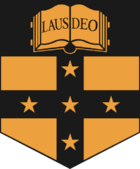 | |
| Location | |
|
Darlinghurst, Edgecliff and St Ives, Sydney Australia | |
| Coordinates | 33°52′29″S 151°12′47″E / 33.87472°S 151.21306°ECoordinates: 33°52′29″S 151°12′47″E / 33.87472°S 151.21306°E |
| Information | |
| Type | Independent, day school |
| Motto |
Latin: Laus Deo ("Praise be to God") |
| Religious affiliation(s) | None |
| Established | 1857[1] |
| Founder | Laurence Hynes Halloran |
| Chairman | David Kirk MBE[2] |
| Headmaster | R. B. Malpass |
| Staff |
63 (Darlinghurst),[3] 15 (Edgecliff),[3] 21 (St Ives)[3] |
| Teaching staff |
153 (Darlinghurst),[3] 52 (Edgecliff),[3] 47 (St Ives)[3] |
| Gender | Boys |
| Enrolment |
1,152 (Darlinghurst),[3] 306 (Edgecliff),[3] 413 (St Ives)[3] (2011) |
| Colour(s) | Black and gold |
| Athletics | AAGPS |
| Website | sydgram.nsw.edu.au |
Sydney Grammar School (colloquially known as Grammar or SGS)[4] is an independent, non-denominational, day school for boys, located in Darlinghurst, Edgecliff and St Ives, which are all suburbs of Sydney, Australia.
Incorporated in 1854 by Act of Parliament[5] and opened in 1857, the school claims to offer a "classical" or "grammar" school education thought of as liberal, humane, pre-vocational pedagogy.[4]
Sydney Grammar School currently has an enrolment of approximately 1841 students from kindergarten to Year 12, over three campuses.[6] The two preparatory schools (K to 6), are located at Edgecliff in Sydney's Eastern Suburbs,[7] and St Ives, on the Upper North Shore.[8] The historic College Street campus caters for students from Forms I to VI (Years 7–12), and is in Darlinghurst, close to the Sydney central business district.[7]
The school is affiliated with the Association of Heads of independent schools of Australia (AHISA),[9] the Junior School Heads Association of Australia (JSHAA),[10] the Headmasters' and Headmistresses' Conference,[11] and is a founding member of the Athletic Association of the Great Public Schools of New South Wales (AAGPS).[12]
Out of all schools in Australia, Sydney Grammar School has educated the highest number of Australian Prime Ministers,[13] Rhodes Scholars,[14] [15] [16] and High Court of Australia judges (Australia's highest court). [17] [18]
As of 2018, it ranked the 5th most expensive school in Australia with an average annual school fee of $35,241 per student.[19]
History
Foundation

The Sydney Public Free Grammar School opened in 1825 with Laurence Hynes Halloran, born County Meath, Ireland (1765–1831) as Head Master. Halloran had operated a private school in Exeter, England, but fled England in 1796 due to debts and after being accused of immorality. It subsequently emerged that his degrees (in divinity) were self-awarded. He eventually returned to Britain but was arrested for forgery and transported to the penal colony of New South Wales, arriving there in 1819. He was immediately granted a ticket-of-leave.
In 1830, Sydney College was founded. Sir Francis Forbes, Chief Justice of New South Wales, became President of the College[20] and laid the foundation stone of the present building in College Street on 26 January 1830. In 1835, Sydney College opened in this building with W.T. Cape as Head Master. In 1842 he resigned and was succeeded by T.H. Braim. In 1850 Sydney College was closed.
In 1854, Sydney Grammar School (SGS) was incorporated by an Act of Parliament[5] and acquired the land and building in College Street which had been temporarily occupied by the newly founded University of Sydney in 1852. It was opened on 3 August 1857, specifically as a feeder school for the University.
The preamble of the Sydney Grammar School Act 1854 states that:
It is deemed expedient for the better advancement of religion and morality and the promotion of useful knowledge to establish in Sydney a public school for conferring on all classes and denominations of Her Majesty’s subjects resident in the Colony of New South Wales without any distinction whatsoever the advantages of a regular and liberal course of education.[21]
The Act provides that the Trustees of the School shall consist of twelve persons, of whom six shall be persons holding the following offices respectively:
- The Honourable the Attorney-General of New South Wales
- The Honourable the President of the New South Wales Legislative Council
- The Honourable the Speaker of the New South Wales Legislative Assembly
- The Chancellor of the University of Sydney
- The Principal Professor of Classics of the University of Sydney
- The Senior Professor of Mathematics of the University of Sydney
The Act also provides that the Governor of New South Wales shall be the official Visitor of the School.
Site history
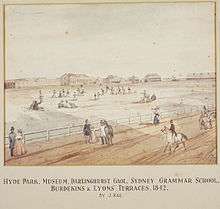
Sydney Grammar School is the oldest school still in use in the City of Sydney, and is also historically significant as the site on which the University of Sydney began. The School also holds scientific significance as containing examples of early building materials and techniques in pre-Federation Australia.[22]
The site was founded as The Sydney College in 1830, and the following year began operations in a new building in Hyde Park designed by Edward Hallen. It consisted of a single large room (now known as "Big School") with basement rooms beneath. Sydney College continued despite financial difficulties until 1853, when it was taken over by the fledgling University of Sydney until such time as the present Grose Farm site was ready for occupation. The site was then sold in 1856 to the Trustees of the newly incorporated Sydney Grammar School, which had been established and endowed with a building fund by Act of Parliament. Edmund Blacket was commissioned to design extensions to the south and north of the Hallen building (now the North and South Blacket rooms), which were completed in 1856 and 1857 respectively. The "Big School" building became central to the Colonial Architect, James Barnet's vision for the cultural focus of Sydney Town.[23]
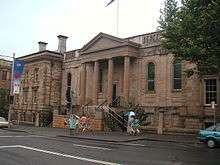
The War Memorial wing, named for its position behind Big School's monument to the Great War, was built at the northern end of Big School in 1953 by the Scott brothers, at the cost of its double staircase. In 1876, the main building was extended to the east by Mansfield Brothers, and this extension was itself extended to the north and south in 1899 by John W Manson. The Science classrooms on Stanley Street were built in 1889–90. Other early buildings on the site, now demolished, included the Sergeant's Lodge, an ablutions block (known as the "White House") on Stanley Street, and a former postal sorting office on Yurong Street (now the Palladium building).
Today
Sydney Grammar is a private school.[24] Each year up to 26 full scholarships are offered to boys who show academic promise and who perform well in the scholarship examination. Currently, it is regarded as one of the most academically proficient private schools in NSW and performs consistently well in the Higher School Certificate.[25]
Tuition is A$31,419 per year (for Forms I – VI, non-boarding).[26]
Sydney Grammar is located near the Sydney central business district. The campus is compact and consists of multi-storey buildings (of up to eight floors) in a concrete landscape setting. Sydney Grammar is situated on the eastern side of Sydney's Hyde Park, next to the Australian Museum, and extends from College Street to Yurong Street. The designs of the School's buildings illustrate many different architectural eras: "Big School" (dating from the early 19th century colonial era), the Blacket buildings (annexed onto either side of "Big School" and completed in the 1850s), the original Science building (1891), the Science laboratory block (1960s), the Palladium building (an example of 1970s Modernist architecture), the Stanley Street building and Alastair Mackerras Theatre (1980s), and the A. B. 'Banjo' Paterson Library (1990s).
Weigall, the School's sportsground (named after former Headmaster Albert Bythesea Weigall), is located at Rushcutters Bay next to the Edgecliff Preparatory School and includes tennis courts, cricket nets and three fields for cricket, rugby and football. It is routinely used for Saturday sports matches, physical education and as a recreational area for Grammar's Edgecliff Preparatory School next door. There is also a large gymnasium at College Street and full rowing facilities at the School's boatshed at Gladesville.
In May 2005, Headmaster John Vallance announced that the School would lead a consortium to purchase 30 Alma St Paddington, known as White City, from Tennis New South Wales, thus extending the Weigall grounds substantially.[27] In 2006, development applications to subdivide the White City tennis courts (numbered DA 20/2006 and DA 302/2006) were lodged with Woollahra Council to develop the site to accommodate more tennis and basketball courts; these were subsequently passed.
On 14 June 2008 the new field now known as Weigall 4 was opened with a range of guests including Mr Frank Lowy, President of Football Federation Australia.
In 2009, the School began the construction of a new, underground multi-purpose hall featuring a seating capacity of over 1500 seats, now called the John Vallance Hall (formerly The New Hall from its opening until 2017).[28] Completed in August 2011, it was primarily designed to accommodate the entirety of the current students and teaching staff under one roof while being acoustically sound for orchestral performances. Notably the hall is unique as it has been built beneath the playground and is substantially subterranean as a result. Much of the naturally occurring Sydney sandstone has been left in place which adds to the aesthetic and acoustic value of the space. The hall was officially opened by the Headmaster on 18 August 2011 with a substantive celebratory concert featuring performances from a large number of Grammar boys past and present. The John Vallance Hall is now used by the two preparatory schools as well.
Headmasters
The current Headmaster of Sydney Grammar School is Richard Malpass, who replaced John Vallance when he retired on 7 April 2017.
| Years | Sydney College |
|---|---|
| 1825-1827 | Laurence Hynes Halloran |
| 1835–1841 | William Timothy Cape |
| 1841–1846 | Thomas Henry Braim, MA |
| 1847–1849 | David Patterson |
| 1850 | Charles Woodward, LLB |
| Years | Sydney Grammar School |
| 1857–1866 | William John Stephens, MA |
| 1867–1912 | Albert Bythesea Weigall, CMG, MA |
| 1913–1920 | H. N. P. Sloman, MC, MA |
| 1920–1923 | Arthur Henry Shakespeare Lucas, MA, BSc |
| 1923–1939 | H. S. Dettmann, MA, BCL |
| 1940–1950 | Frederick George [Sandy] Phillips, MA |
| 1951–1964 | C. O. Healey, OBE, TD, MA |
| 1965–1968 | S. P. T. Houldsworth, MA, DipEd |
| 1969–1989 | A. M. Mackerras, AO, MA |
| 1989–1999 | Ralph D. Townsend, MA, D.Phil |
| 1999–2017[29] | John T. Vallance, MA, PhD |
| 2017–present | Richard B. Malpass, BA, PhD |
Structure
Sydney Grammar has a total enrolment of approximately 1,833 boys across Years K–12.[30] In Term Three of 2006, the main high School campus had an enrolment of 1,109 boys in Forms I–VI (Years 7–12). The main high school is divided into the Lower School (First Form) and the Upper School (Second through Sixth Forms). There are also two Preparatory Schools, one at St. Ives in the Northern Suburbs (440 boys) and the other at Edgecliff in the Eastern Suburbs (304 boys). Each year, approximately two-thirds of the incoming Form I at College Street are from the two Preparatory Schools, while the rest are drawn from schools in Sydney, from interstate and overseas.
Curriculum
Sydney Grammar offers a liberal, pre-vocational type education, and this is reflected in its academic structure and subject choices. The academic departments are:
- Classics
- Design and technology (currently known as applied arts)
- Economics
- English
- Geography
- History
- Mathematics
- Modern languages (Asian and European)
- Music
- Physical education
- Science
- Visual arts.
Subjects offered for the Higher School Certificate (HSC) include English Advanced, English Extension 1, English Extension 2, Mathematics, Mathematics Extension 1, Mathematics Extension 2, Chemistry, Physics, Biology, Earth and Environmental Science, Geography, Modern History, Ancient History, History Extension, Economics, Latin, Latin Extension, Classical Greek, Classical Greek Extension, French Continuers, French Extension, Italian Continuers, Italian Extension, German Continuers, German Extension, Chinese Continuers, Chinese Extension, Japanese Beginners, Music 1, Music 2, Music Extension, Visual Art, PDHPE, Design and Technology and Studies of Religion. Sanskrit and Special Academic Courses are offered as non-HSC subjects. The Special Academic courses previously included a Form V (Year 11) course in extension chemistry and physics and a Form VI (Year 12) course in lagrangian dynamics and quantum mechanics; they are currently centred around 19th Century Russian literature, with a focus on the works of Pushkin and Dostoevsky, with a smaller study of Chekhov and Nikolai Gogol. The school will also be offering drama as a subject for students onwards of 2018.
Co-curriculum
Sydney Grammar School co-curriculum is very strong and is unique among Australian schools because it has been recognised at a national and international level across such a broad variety of areas. In addition to sport, drama, and many clubs and societies, some examples include:
- Sydney Grammar School Music has won the national AMEB Schools Shield (Australian Music Examinations Board) the most times out of all schools in Australia (23 times in last 25 years). [31]
- Sydney Grammar School Debating has produced the highest number of Australian National Debating Champions and the highest number of Team Australia representatives at the World Schools Debating Championships out of any school in the country in the last 20 years. [32] [33] With 9 wins, Australia is also the most successful country in the world at the World Schools Debating Championships. [34] In the past six years alone, for four years, the Australian Team Captain at the World Schools Debating Championships has been a Sydney Grammar School student. [35] [36]
- Sydney Grammar School Chess has won the Australian Schools Team Chess Championships three times since its inception, only four schools in all of Australia have achieved this.[37]
- Sydney Grammar School Academic Extension meets a strong internationally competitive standard. For instance, Sydney Grammar School and James Ruse Agricultural High School are the only high schools in all of Australia that produce Australian representatives at the International Science and Mathematics Olympiads effectively every year. [38] [39] Sydney Grammar produces on average around 2 International Science/Mathematics Olympians every year, winning Bronze, Silver, or Gold medals. Many graduates have attended Harvard, MIT, Yale, Princeton, Oxford, and Cambridge. [40] In 2016, as mentioned more below, Sydney Grammar year 11 students also attracted worldwide attention for their synthesis of medication pyrimethamine (sold as Daraprim) and its relation to Turing Pharmaceuticals and CEO Martin Shkreli.[41]
Music
SGS has won the AMEB Music Shield twenty-three times in the past twenty-five years. [31] Two-thirds of pupils in the School play a musical instrument or are involved with music in some way. SGS boasts scores of musical groups in mostly classical, chamber and jazz styles. The School Orchestra has received wide acclaim and frequently engages in both national and international tours. Grammar's choir program involves hundreds of students, old boys, and parents, participating in its many annual concerts. The School's senior a cappella group is known as The Grammarphones and is composed of the best tenors, basses and baritones in the senior years. The School's senior big band, the Sydney Grammar School Big Band, is a regular feature at the Manly Jazz Festival.
SGS embarked on a five-year program entitled "Bach: 2010", in which all the known choral cantatas of Johann Sebastian Bach were performed in a series of concerts between 2005 and 2010.[42] Sydney Grammar is one of the few institutions in the world that has engaged in such an exercise and was aided by the Mander organ in the Big School.[43] A performance has been held every year since by head of practical music studies, Robert Wagner, on the Bach’s birthday.[44]
Under the current Head Master, an organic rock-&-roll movement has emerged and is currently thriving. The end of 2004 saw the consummation of years of practice in the first Grammarpalooza rock concert, which included the musical style of Old Boy band, Dappled Cities Fly.
Sport
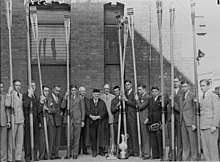
Sydney Grammar School is a member of the Athletic Association of the Great Public Schools of NSW (GPS). GPS sporting events are contested in rugby union, football, cricket, tennis, volleyball, cross country, basketball, rowing, swimming, athletics, rifle shooting, and debating.[45][46] The School also competes in fencing and chess[47] competitions.
Grammar participates in the annual Tri-Grammar competitions, a series of cricket competitions between the Firsts teams of Sydney Grammar School, Melbourne Grammar School and Brisbane Grammar School. Sydney and Melbourne Grammar School also compete for "The Bat" in the same competition. The Sydney–Melbourne match dates back to 1876, and in 1976, to mark the centenary of this rivalry, a "Bat" was struck, with the winner of the annual match taking possession. The bat was donated by John Crawford, the father of the captain of the 1976 premiership winning side Andrew Crawford.
Grammar was the first Sydney school to take to the water in 1878 at a time when there were only a handful of senior rowing clubs in existence on Sydney Harbour and its reaches.[48] Competition in rowing culminates in the Riverview Gold Cup for Junior Crews and the Head of the River for Senior Crews. Grammar's boatshed is on the Parramatta River at Gladesville.
On 2 April 2011, the Sydney Grammar School first eight won the Major Rennie Trophy at the AAGPS Head of the River.[49] The win was significant for Grammar as it heralded the return of the trophy to the School for the first time in more than thirty years. Many rowers have gone on to attend universities like Harvard University, and row in Varsity Crews. [50]
Academic extension
The school operates academic extension programmes in both sciences and humanities, which includes olympiad programmes and hosting visiting scholars who spend time teaching and giving a public lecture. Notable scholars have included metaethicist Simon Blackburn, science and medical historian Sir Geoffrey Lloyd, zoologist Andrew Parker, astronomer and 1999 Young Australian of the Year Bryan Gaensler, historian Sir Christopher Clark, Professor of English Dame Marina Warner, Professor of Greek Richard Hunter, and composer Robin Holloway.[51]
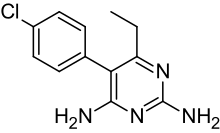
As part of an academic extension activity, a group of year 11 students attempted to prepare the medication pyrimethamine (sold as Daraprim) in 2016. Pyrimethamine is on the World Health Organization's List of Essential Medicines, the most important medications needed in a basic health system, for both adults[52] and children.[53] It is used to treat toxoplasmosis,[54] cystoisosporiasis, and malaria (in combination with sulfadoxine).[55] It is on the World Health Organization's List of Essential Medicines, the most important medications needed in a basic health system.[56] It received significant attention when its manufacturer in the United States was acquired by Turing Pharmaceuticals, and its CEO Martin Shkreli decided to increase the price from US$13.50 to US$750 a dose.[57][58] Hence, a group of year 11 students from Grammar, supported by the University of Sydney and the Open Source Malaria consortium, have prepared pyrimethamine.[59] The students started with 17 g of (4-chlorophenyl)acetonitrile (which is available from Sigma-Aldrich for $36.50 per 100 g) and prepared 3.7 g of pyrimethamine, which is about US$110,000 at Turing's prices.[60]
Their work has attracted attention from around the world, being reported in The Independent,[61] the Daily Telegraph,[62] and BBC News[63] in the United Kingdom, the Washington Post,[64] New York Daily News,[65] and U.S. News & World Report[66] in the United States, among others.[67] By replacing expensive chemicals with alternatives available in a high school laboratory, they demonstrated that the synthesis can be carried out fairly simply and safely, and at a cost of approximately $2 per dose[68] (US$1.48[41]). Business magazine Forbes described the work as figuratively "punch[ing] Martin Shkreli in the face" and as raising questions about pharmaceutical companies which do not do substantial amounts of research.[41] Unfortunately, as a consequence of the closed distribution model which Turing employs in the United States, any competing company seeking to market a generic alternative to Daraprim (including using the approach the boys developed with their teacher) would need to compare their product with a sample of Daraprim provided directly by Turing; if Turing refuses to provide that sample, the competitor would need to undertake a complete new clinical trial,[62] which creates a prohibitive barrier to entering the market. The boys are quoted making comments highly critical of Shkreli's and Turing's behaviour,[59][63][68] and have been applauded on social media with comments that their work highlight's Shkreli's greed, though he has minimised their achievement.[64] Shkreli subsequently posted a video about the achievement, declaring his "delight" about students entering the STEM field, describing them as "proof that the 21st century economy will solve problems of human suffering through science and technology", and stating that "[w]e should congratulate these students for their interest in chemistry and all be excited about what is to come in the STEM-focused 21st century."[69] The students presented their work at the Royal Australian Chemical Institute's NSW Organic Chemistry symposium alongside students at fourth-year undergraduate and postgraduate levels, as well as postdoctoral researchers.[60]
Extra-curricular
The school has numerous clubs and societies for students. Notable examples include:
- Australian Air Force Cadets[70] (Established in 1942[71])
- Australian Army Cadets[70] (Founded in 1871 by School Headmaster Albert Bythesea Weigall, the Corps is one of the oldest military units in the nation, even predating the Australian Army.[22][72])
- Creative Writing Club,[70] run by notable author John Hughes
A number of boys also assist in editing the School's yearly almanac, The Sydneian,[70] over 400 editions of which have been produced since 1875.
Overseas tours
The school offers its students the opportunity to attend various overseas tours for educational and cultural exchanges. The school has partnerships with some of the top schools around the world in cities such as Paris, Shanghai and Florence which students can visit for a period of between 3 and 12 weeks as a supplement for their linguistic studies; in addition to the time spent at the school, the boys also get the opportunity to travel around the respective countries on a cultural trip, accompanied by teachers. There are also frequent sporting tours overseas such as in Brazil for football, England for rugby and Japan for volleyball where the students can participate in matches against foreign teams and sometimes even train with and watch professional sports teams play. The school also offers tours for science, geography and history to areas such as the Galapagos to study evolution or to the Kokoda Track to follow in the footsteps of the ANZACs.
Notable alumni
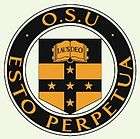
Alumnus of Sydney Grammar School are commonly referred to as Old Boys or Old Sydneians,[73] and may elect to join the schools alumni association, the Old Sydneians' Union (OSU).[74][75]
Grammar is notable for having educated the highest number of Australian Prime Ministers,[76] Rhodes Scholars,[77] [78] [79] and High Court judges (Australia's highest court) out of any school in the country. [80] [81]
Notable alumni include Sir Edmund Barton, the first Prime Minister of Australia (1901–1903),[82] Sir William McMahon, 20th Prime Minister of Australia (1971–1972),[83] Malcolm Turnbull, 29th Prime Minister of Australia (2015-2018),[84] Bruce Gyngell, first person to appear on Australian television,[85] Andrew "Boy" Charlton, an Olympic gold medallist swimmer,[86] and also Banjo Paterson – bush poet and balladist, and author of "The Man From Snowy River" and "Waltzing Matilda," and who now has a library in the school named after him.
References
- ↑ "Sydney Grammar School". New South Wales. School Choice. 2007. Retrieved 25 October 2007.
- ↑ "Grammar Newsletter, 16 February 2011" (PDF). Sydney Grammar School.
- 1 2 3 4 5 6 7 8 9 "My School". NSW Government. NSW Government. 2011. Retrieved 31 March 2011.
- 1 2 Vallance, J.T. (2007). "Headmaster's Introduction". College St. Sydney Grammar School. Archived from the original on 15 October 2007. Retrieved 25 October 2007.
If you think you might like to come to Grammar
- 1 2 "Sydney Grammar School Act 1854". New South Wales Consolidated Acts. AustLII. 10 May 1995. Retrieved 25 October 2007.
- ↑ "2006 Annual Report" (PDF). Annual Reports. Sydney Grammar School. 2007. Archived from the original (PDF) on 29 August 2007. Retrieved 25 October 2007.
- 1 2 "Sydney Grammar School". Directory. Sydney's Child. Archived from the original on 19 October 2007. Retrieved 25 October 2007.
- ↑ "Sydney Grammar School". Participating schools. North Shore independent schools. 10 May 1995. Retrieved 25 October 2007.
- ↑ "AHISA Schools". New South Wales. Association of Heads of independent schools of Australia. April 2007. Archived from the original on 29 August 2007. Retrieved 25 October 2007.
- ↑ "JSHAA New South Wales Directory of Members". New South Wales Branch. Junior School Heads' Association of Australia. 2007. Archived from the original on 17 January 2008. Retrieved 25 October 2007.
- ↑ "HMC Schools: International Members". HMC Schools. Headmasters' and Headmistresses' Conference. 2007. Archived from the original on 15 March 2008. Retrieved 25 October 2007.
- ↑ "AAGPS History". Info. Athletic Association of the Great Public Schools of New South Wales. 2007. Archived from the original on 1 May 2008. Retrieved 11 October 2007.
- ↑ "List of Australian Prime Ministers by Education".
- ↑ "Sydney Grammar School 26th Rhode Scholar in 2005".
- ↑ "University of Sydney, Sydney Grammar School 27th Rhode Scholar in 2006".
- ↑ "Sydney Grammar School 28th Rhode Scholar in 2013".
- ↑ "Sydney Grammar School High Court of Australia judges alumni, 7 judges".
- ↑ "Complete list of High Court of Australia judges".
- ↑ http://www.exfin.com/private-school-costs
- ↑ Latin Language Inscriptions in Sydney, australiaforvisitors.com. Retrieved 27 August 2017.
- ↑ "Sydney Grammar School Act 1854 (Private Act)". NSW legislation. Parliamentary Counsel's Office. Retrieved 25 October 2007.
- 1 2 "Sydney Grammar School". Sydney Architecture Images- Central Business District. Sydney Architecture. 2004. Retrieved 11 March 2008.
- ↑ "History". SGS Archives. Sydney Grammar School. 2003. Archived from the original on 8 March 2008. Retrieved 12 March 2008.
- ↑ Patty, Anna (30 July 2007). "Lessons in choice". News and Features. Sydney: The Sydney Morning Herald. p. 14. Retrieved 11 March 2008.
- ↑ Doherty, Linda; Norrie, Justin; Burke, Kelly (17 December 2005). "State school blitz of top HSC spots". The Sydney Morning Herald. Retrieved 11 September 2007.
- ↑ "Fees". Enrolment. Sydney Grammar School. 2015. Retrieved 18 January 2015.
- ↑ Dick, Tim (24 May 2005). "Match point in tennis centre sale". The Sydney Morning Herald. Retrieved 11 September 2007.
- ↑ "Our largest building project?" (PDF). Foundations. November 2009. Retrieved 15 August 2011.
- ↑ https://sslcam.news.com.au/cam/authorise?channel=pc&url=http%3a%2f%2fwww.theaustralian.com.au%2fnational-affairs%2feducation%2fsydney-grammar-school-headmaster-john-vallance-resigns%2fnews-story%2fc0fd64ccb0a58097974ca778a7df2924
- ↑ "2006 Annual Report" (PDF). Annual Reports. Sydney Grammar School. 2007. Archived from the original (PDF) on 29 August 2007. Retrieved 25 October 2007.
- 1 2 "Sydney Grammar School Magazine". Winter 2018. p. 17.
- ↑ "New South Wales Debating Union Team History".
- ↑ "New South Wales Debating Union Team History".
- ↑ "Australia with 9 wins, most successful country at World Schools Debating Championships; next is England with 5".
- ↑ "School Debating in Australia summary".
- ↑ "New South Wales Debating Union Team History".
- ↑ "Australian Schools Team Chess Championship Results history".
- ↑ "Australia International Science Olympiad Honour Roll history".
- ↑ "Australia International Mathematics Olympiad History".
- ↑ "Sydney Grammar School Magazine June 2012, see page 3".
- 1 2 3 Lee, Bruce Y. (1 December 2016). "High Schoolers Punch Martin Shkreli In The Face, Figuratively". Forbes. Retrieved 3 December 2016.
- ↑ "Sydney Grammar School". Conference Program – Sydney. Organ Historical Trust of Australia. 2005. Retrieved 11 March 2008.
- ↑ "Sydney Grammar School". Portfolio. Mander Organs. 2003. Retrieved 11 March 2008.
- ↑ "Bach's 330th birthday organ concert - Robert Wagner @ Sydney Grammar". Meetup. Retrieved 2018-02-09.
- ↑ "Sport". Sydney Grammar School.
- ↑ "Debating". Sydney Grammar School.
- ↑ "Chess". Sydney Grammar School.
- ↑ http://www.rowinghistory-aus.info/club-histories/sydney/03-1.php Early rowing clubs
- ↑ "AAGPS Head of the River Results 2011" (PDF). 2010 – 2011 Regatta Calendar. Rowing NSW. Retrieved 7 May 2011.
- ↑ "Sydney Grammar School Magazine June 2012, see page 3".
- ↑ Academic Extension, Sydney Grammar School, 2016
- ↑ WHO Model List of Essential Medicines (PDF) (19th ed.). World Health Organization. November 2015.
- ↑ WHO Model List of Essential Medicines for Children (PDF) (5th ed.). World Health Organization. August 2015.
- ↑ Hamilton, Richard J. (2015). Tarascon Pocket Pharmacopoeia 2016 Deluxe Lab-Coat Edition. Jones & Bartlett Learning. p. 63. ISBN 9781284095289.
- ↑ American Society of Health-System Pharmacists (8 February 2016). "Pyrimethamine". Drugs.com. Retrieved 2 December 2016.
- ↑ "WHO Model List of EssentialMedicines" (PDF). World Health Organization. October 2013. Retrieved 22 April 2014.
- ↑ Pollack, Andrew (20 September 2015). "Drug Goes From $13.50 a Tablet to $750, Overnight". The New York Times. Retrieved 3 December 2016.
- ↑ Mullin, Emily (21 December 2015). "Turing Pharma Says Daraprim Availability Will Be Unaffected By Shkreli Arrest". Forbes. Retrieved 10 November 2016.
- 1 2 Davey, Melissa (December 1, 2016). "Australian students recreate Martin Shkreli price-hike drug in school lab". The Guardian. Retrieved December 1, 2016.
- 1 2 Strom, Marcus (30 November 2016). "Sydney schoolboys take down Martin Shkreli, the 'most hated man in the world'". Sydney Morning Herald. Retrieved 3 December 2016.
- ↑ Garcia, Feliks (1 December 2016). "Martin Shkreli-hiked drug Daraprim recreated by Australian schoolboys for $20 a pill". The Independent. Retrieved 3 December 2016.
- 1 2 Palazzo, Chiara (2 December 2016). "Breaking good: Australian schoolboys reproduce Martin Shkreli-hiked drug for £1 a pill". Daily Telegraph. Retrieved 3 December 2016.
- 1 2 Dunlop, Greg (2 December 2016). "Martin Shkreli: Australian boys recreate life-saving drug". BBC Online. Retrieved 3 December 2016.
- 1 2 Schmidt, Samantha (1 December 2016). "Sydney high school students 'show up' Martin Shkreli, recreating price-hiked pill for $2". The Washington Post. Retrieved 3 December 2016.
- ↑ Salinger, Tobias (30 November 2016). "Australian high school boys create Martin Shkreli's price-hiked drug using $20 and science". New York Daily News. Retrieved 3 December 2016.
- ↑ Dicker, Rachel (1 December 2016). "Australian High School Students Make Martin Shkreli's $750 Daraprim Drug for $2 per Pill". U.S. News & World Report. Retrieved 3 December 2016.
- ↑ Ghoshal, Arkadev (1 December 2016). "Take that, Pharma Bro: Australian students recreate $110,000 AIDS drug ingredient for $20". International Business Times (India Edition). Retrieved 3 December 2016.
- 1 2 Davey, Melissa (2 December 2016). "Martin Shkreli branded an 'attention seeker' as Sydney student hits back". The Guardian. Retrieved 3 December 2016.
- ↑ "Martin Shkreli responds to Sydney schoolboys who recreated drug in Daraprim". The Australian. 2 December 2016. Retrieved 3 December 2016.
- 1 2 3 4 "Clubs and Societies". College Street. Sydney Grammar School. Archived from the original on 21 January 2008. Retrieved 11 March 2008.
- ↑ "A brief history of 306 Squadron". About 306 Squadron. Australian Air Force Cadets. Archived from the original on 23 July 2008. Retrieved 11 March 2008.
- ↑ J. B. Windeyer (1976). "Weigall, Albert Bythesea (1840–1912)". Australian Dictionary of Biography Vol. 6. MUP. pp. 375–376. Retrieved 12 August 2007.
- ↑ "Old Sydneians' Union". College St. Sydney Grammar School. 2007. Archived from the original on 8 October 2007. Retrieved 25 October 2007.
- ↑ "Old Sydneians' Union". Welcome. OSU Sydney Grammar School Old Sydneians' Union. 2007. Retrieved 25 October 2007.
- ↑ "Membership". Membership. OSU Sydney Grammar School Old Sydneians' Union. Retrieved 25 October 2007.
- ↑ "List of Australian Prime Ministers by Education".
- ↑ "Sydney Grammar School 26th Rhode Scholar in 2005".
- ↑ "University of Sydney, Sydney Grammar School 27th Rhode Scholar in 2006".
- ↑ "Sydney Grammar School 28th Rhode Scholar in 2013".
- ↑ "Sydney Grammar School High Court of Australia judges alumni, 7 judges".
- ↑ "Complete list of High Court of Australia judges".
- ↑ "Edmund Barton". Player Profile. cricinfoaustralia. Retrieved 11 March 2008.
- ↑ "William McMahon". Fast Facts – Australia's Prime Ministers. National Archives of Australia. Archived from the original on 31 August 2007. Retrieved 11 March 2008.
- ↑ http://www.9news.com.au/national/2015/09/14/22/29/malcolm-turnbull-the-man-who-always-thought-he-was-king
- ↑ "GYNGELL, BRUCE". Archives. The Museum of Broadcast Communications. Retrieved 11 March 2008.
- ↑ "Andrew "Boy" Charlton – An Australian Legend". Dive into spring. Sydney Media. 1 September 2006. Archived from the original on 27 September 2007. Retrieved 11 March 2008.
Further reading
- Sheldon, J.S 1997. The Big School Room at Sydney Grammar School with an Account of the Decline & Fall of Sydney College. Sydney Grammar School Press, Sydney, NSW. ISBN 0-646-30507-7.
- Turney, C. 1989. Grammar: A History of Sydney Grammar School 1819 – 1988. Allen & Unwin with Sydney Grammar School, Sydney, NSW. ISBN 0-04-910115-3.